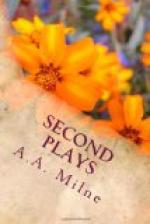Of the one-act plays, The Camberley Triangle and The Stepmother, nothing much need be said. The former was played at the Coliseum; the latter, written for Miss Winifred Emery, was deemed by the management too serious for that place of amusement. This, however, was to the great advantage of the play, for now it has appeared only at Charity matinees with an “all-star” cast.
As before, the plays are printed in the order in which they were written; in this case between October 1918 and June 1920. May the reader get as much enjoyment from them as I had in their writing. But no; that is plainly impossible.
A.A. MILNE.
MAKE-BELIEVE
A CHILDREN’S PLAY IN A PROLOGUE AND THREE ACTS
Make-Believe was first produced at the Lyric Theatre, Hammersmith, on December 24, 1918. The chief parts were played by Marjory Holman, Jean Cadell, Rosa Lynd, Betty Chester, Roy Lennol, John Barclay, Kinsey Peile, Stanley Drewitt, Ivan Berlyn, and Herbert Marshall—several parts each.
MAKE-BELIEVE
PROLOGUE
The playroom of the HUBBARD FAMILY—nine of them. Counting MR. and MRS. HUBBARD, we realize that there are eleven HUBBARDS in all, and you would think that one at least of the two people we see in the room would be a HUBBARD of sorts. But no. The tall manly figure is JAMES, the HUBBARDS’ butler, for the HUBBARDS are able to afford a butler now. How different from the time when Old Mother Hubbard—called “old” because she was at least twenty-two, and “mother” because she had a passion for children—could not even find a bone for her faithful terrier; but, of course, that was before HENRY went into work. Well, the tall figure is JAMES, the butler, and the little one is ROSEMARY, a friend of the HUBBARD FAMILY. ROSEMARY is going in for literature this afternoon, as it’s raining, and JAMES is making her quite comfortable first with pens and ink and blotting-paper—always so important when one wants to write. He has even thought of a stick of violet sealing-wax; after that there can be no excuse.




